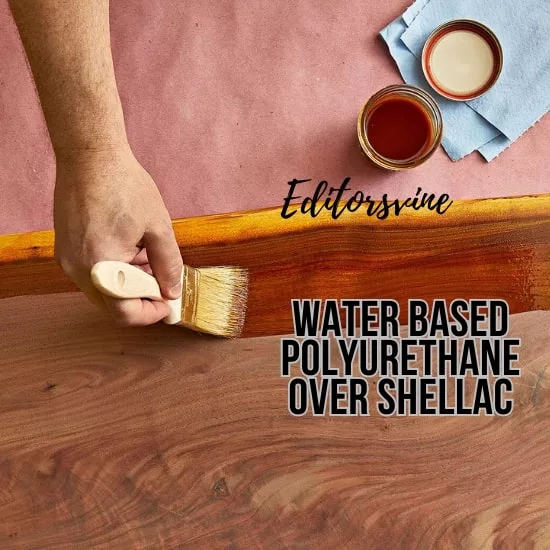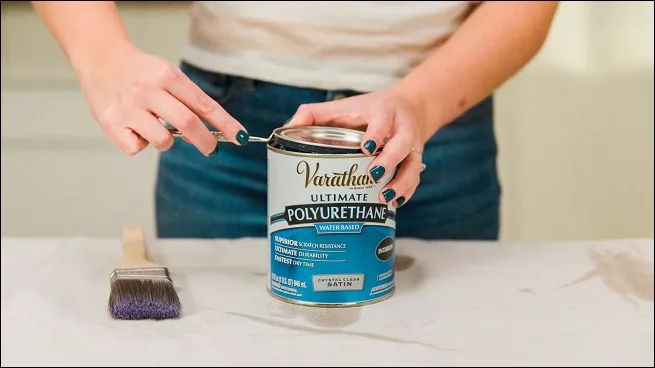
If you ever owned wooden furniture, indeed, the most common question that ever came across your mind was, “what will be the best finish for my wood?” A finish has become a necessity for protecting wood surfaces.
There are numerous finishes in the market now, such as polyurethane, shellac, varnish, or lacquer. You can choose anyone, and it’s up to you. First, however, you have to decide based on the best interest of your wooden furniture or floor.
To be specific, water-based polyurethane is recommended by various users as a perfect finish. But what if you already put a shellac finish on your wooden material?
You may wonder, can you put water based polyurethane over shellac? Does water-based poly work over shellac? Let’s jump into the answers to your questions right now!
Which Is Better: Water Based Polyurethane Or Shellac?
To know the better one, first, we have to understand what their features are. Here, we’ll know more about water-based polyurethane and shellac.
Water-Based Polyurethane
Water-based poly looks transparent on your wood. That is because it extracts the natural raw color from your wood and doesn’t let the color change.
This poly has the feature of solid durability. It can last up to 2-4 years on your wood. So you don’t have to worry about your wood being damaged for 2-4 years!
Toxic chemicals and UV rays are not found in water-based poly. Thus, the safety point increases to +1 if you apply water-based poly on your wooden material.
Water-based polyurethane can resist water and heat. So if you spill water or oil onto your topcoat, don’t panic! Because water-based poly prevents your wood from spots and scratches.
It dries up faster than any other finish! Additionally, water-based doesn’t need a large number of coats to put on.
However, the cost of making water-based poly is quite expensive relative to the other finishes.
Shellac
Shellac is a natural product that has been used as a finish for centuries. It enriches the original beauty of your wooden material.
You can apply it to the wood smoothly and comfortably. If you want your wood to look vivid and captivating, then shellac can be a perfect option for you.
Shellac dries fast so you can put multiple coats of shellac in a day. Nevertheless, there are cons to putting shellac as a finish, especially if you’re using it on your countertop or tabletop.
For instance, water and alcohol spills ruin the shellac finish surface. As a result, these spills can cause damage and scratches to your cherished table or kitchen. Moreover, you may observe a white ring-shaped spot if you put a hot mug or pans on the table.
Shellac is not as durable as the other finishes.
Which One is Better?
If you read the above-noted features, you may already have an idea of the better finish between the two finishes.
If you want rich and vibrant color on your wood, you can choose shellac as your finish.
Opposed to that, if color is not much important according to you, and you want durable and resistant wood, then a water-based poly finish is a perfect option for you.
Here, as can be seen, water-based poly is miles ahead in contrast to shellac.
You might wonder what will happen if you already put shellac on your finish despite wanting a durable and robust finish. So let’s now dive into the real question, shall we?
Can Water-Based Polyurethane Adhere To Shellac?
Imagine a situation. You have put shellac as a finish over your countertop or tabletop. Now you have seen a water spill damage your tabletop. You want to apply polyurethane based on the recommendations of other users.
What Should You Do?
Beforehand, you must know what type of shellac has been put on to your wood, whether the shellac is waxed or dewaxed, as both are very distinct from one another.
What Happens if The Shellac Is De-Waxed?
When the shellac is de-waxed, it can stick to any kind of topcoat. Water-based polyurethane’s one of the features is it searches for physical attachment. Thus, water-based poly attaches with the de-waxed shellac thoroughly.
Another exciting thing is, de-waxed shellac can be used as a coating between stain and water-based poly. Again, it’s because of the rigid bonding material of the dewaxed shellac.
Therefore, if you want to prevent your wood from scratches, spots, and damages, you can apply water-based poly over dewaxed shellac.
What Happens If The Shellac Is Waxed?
The problem arises if your wood has already been wiped with waxed shellac.
As to putting something over waxed shellac, the topcoat needs to be mixed. Water-based poly can’t mix with other chemicals, and instead, it sticks to it. Likewise, waxed shellac can’t adhere to poly.
Thus, it is not recommended to put water-based poly over waxed shellac. Although if it’s urgent, you can apply dewaxed shellac on top of the wax. By doing this, you can quickly put water-based poly as the topcoat over dewaxed shellac.
Applying Water Based Polyurethane Over Shellac
Shellac can stick to any topcoat! Even if the waxed shellac can’t, you can apply dewaxed shellac over waxed one so that the dewaxed shellac can adhere to other finishes.
Let’s look into the steps on how to apply water-based poly over shellac.
Step 1: Sand The Surface
Before anything else, you have to sand the dewaxed shellac finish softly and gently with sandpaper.
You may wipe away the leftover dust, dirt, or oil with a clean brush or cloth.
Step 2: Apply Water Based Polyurethane

In this step, you have to apply water-based poly over the dewaxed shellac on the wooden object. Then, you can wipe it with a paintbrush.
Step 3: Give Time To Dries
You must wait until the first layer of coat dries. It may take at least 2 hours or, based on the instructions on the can.
Step 4: Apply 2nd Layer Of Coat
Put the second layer of coat after the first coat cures. You must put at least 2-3 coats of water-based polyurethane to get a positive outcome.
FAQ
How Can I Tell What Finish Is On My Wood?
You may apply a cotton swab, including acetone on it, to the wood. After applying the swab, if your wood becomes sticky and wet, then you’ll know it is shellac. However, if it creates a string of beads, your wood has a polyurethane finish.
Can You Clear Coat Over Shellac?
If your shellac is dewaxed following that, you can put on any type of topcoat. Dewaxed shellac sticks to every material.
Although waxed shellac doesn’t adhere to other finishes, you can mix it up with dewaxed, and you already know the rest.
Final Words: Polyurethane Over Shellac
You now know that any finish adheres to dewaxed shellac because it sticks to anything! Thus, don’t panic if your wood is damaged even after applying a shellac finish. Instead, you can easily apply water-based polyurethane over shellac.
If you had any confusion about applying water-based poly over shellac, we hope we cleared the uncertainty. Nevertheless, if you still feel somewhat doubt, then you can always re-read this guide.
On all the coating occasions, we advise that you make decisions to better your wooden material, your home, and your family.
